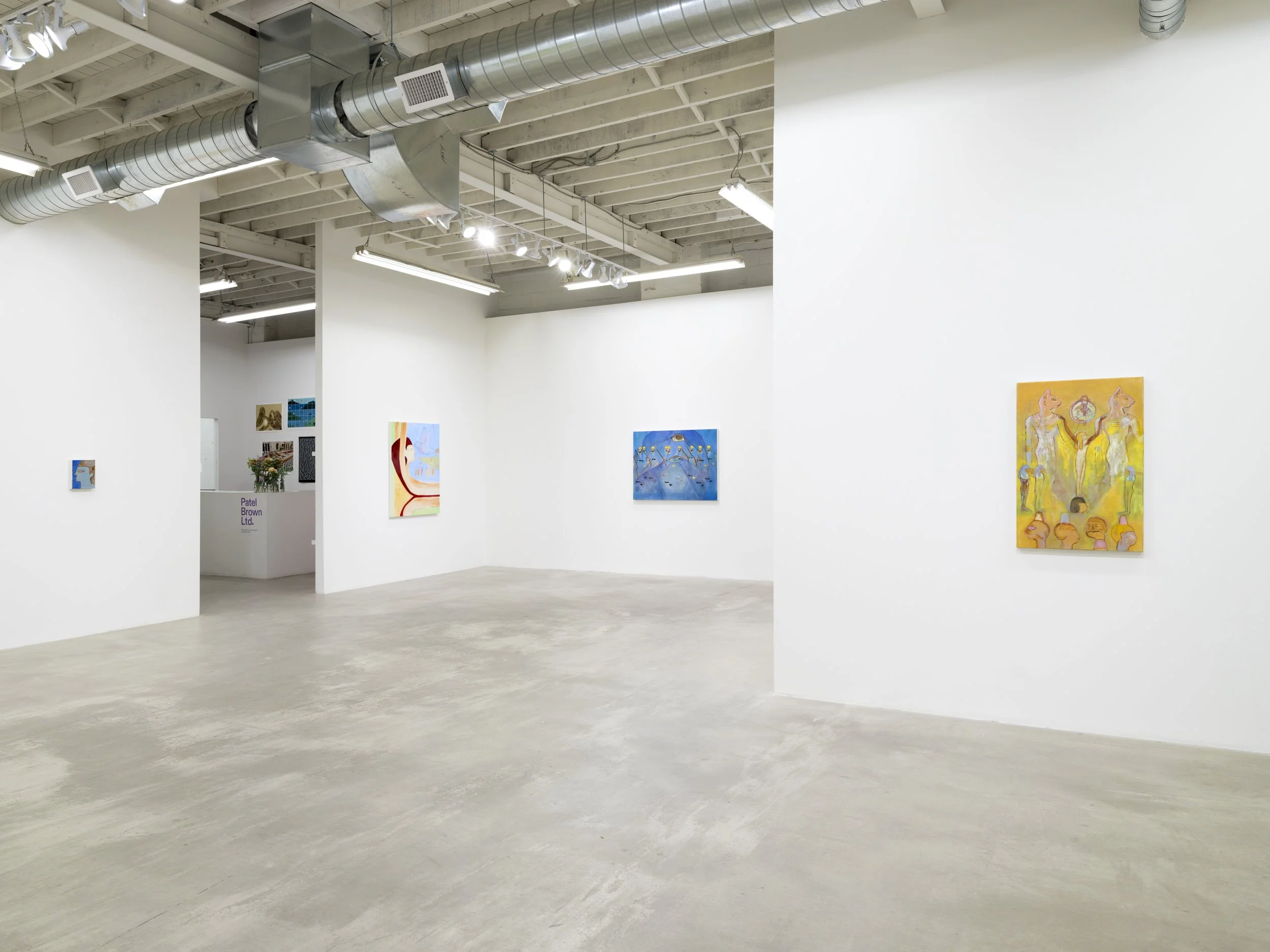21 wade ave, uint 2, toronto
Muriel Ahmarani Jaouich | From lore to foresight | 24 may – 5 Jul, 2025
Vibrant columns and pillar-like figures swathed in robes raise their hands in supplication, offering up a sacred salute to the heavens. The silenced notes of a pipe organ ascend to the skies in the form of ghostly apparitions. Feminine figures stand in symmetrical alignment in the light, shoulder-to-shoulder with their ancestors, sentinels of the invisible but ever-present link between the worlds of the sacred and the material, the past and the present, the forgotten and the remembered. Even if history insists on their separation, these figurative bodies stand as witnesses to a different kind of narrative, and to the different possible forms of healing.
Is painting a truly solitary act? From Lore to Foresight seems to imply that even in solitude, the artist is channeling a collective heritage, especially when it is one of trauma unaddressed. For the deafening silence of unacknowledged histories and the vanished voices of the Armenian genocide are a veritable presence in every one of Muriel Ahmarani Jaouich’s works. Painting becomes a work of visual archeology, a means of preserving living memory.
The walls of her studio are covered with archival photographs, the graphic underpinning of her painterly compositions. Her process is informed by the oral histories passed down to her by her family, as well as the way trauma inhabits the body as an inheritance of generations. Her approach to the material, its superimposed layers made fragile through different treatments — faded, sandblasted, sometimes obliterated — allows for the resurfacing of distant voices and figures distorted by time.
One day she came across a photo of rows of Armenian soldiers’ helmets displayed like trophies in a park in Azerbaijan and found herself transfixed. These helmets, ripped from their context, become a somber procession where each carries the weight of a life cut short. The Egyptian eye with its stylized tear (a reference to the country where the artist’s Armenian family was exiled) both witnesses and condemns — as do all the disproportional faces presiding over so many of her works. Their fixity reinforces the idea of an eternal, lucid gaze that equally surveys past and present, silently taking in all the violence that still ravages Armenia to this day.
The fez, a symbol of Ottoman authority, circumscribes a group of barely sketched out female figures, while others, with their bolder lines, seem determined to resist oblivion. The piece entitled 27 echoes a memory passed down by the artist’s mother, referencing the number assigned to her grandmother at the orphanage where she ended up. It becomes a symbol of resilience, representing the only member of the family to survive the genocide.
Ahmarani Jaouich approaches charged political subjects with a destabilizing gentleness. She employs light, vibrant colors and simple forms that are deconstructed and open. Guided by her intuition, her approach is not limited to simple representation; she rather entices us to a tactile consideration of the canvas, revealing the viewer’s own vulnerability through the delicacy of her treatment.
From Lore to Foresight is an invitation to consider how that which is buried in the depths of personal and collective memory holds immense power, nurturing an inward gaze that allows us to better see what connects people to one another. Her paintings are like subterranean streams, which spring to the surface bearing that which must be seen, heard, known. They call to mind Etel Adnan’s words in her novel Night: “I measure my memory of things, but not memory itself, as the present is also overflowing.”
— Élise Lafontaine, translated by Lina Mounzer
Muriel Ahmarani Jaouich is a Canadian artist of Armenian, Egyptian, and Lebanese descent, exploring themes of genealogy, intergenerational trauma, and historical violence through her paintings. Her work is deeply rooted in her family’s history of diaspora, immigration, and genocide, drawing from oral histories, photographic archives, and inherited objects. Ahmarani Jaouich transforms these sources into narratives that blend memory with imagination, resonating with ancestral grief. Her practice advocates for a continual process of listening, believing that addressing ancestral grief liberates present and future generations.
Currently residing on the unceded indigenous lands of Tiohtià:ke / Montreal, QC, Canada, on Kanien’kehà:ka Peoples territory, she has received recognition through the Lilian Vineberg Scholarship, Merit Scholarship, and Tom Hopkins Memorial Award. Her artworks have been exhibited at Montreal Museum of Fine Arts, Patel Brown, CLARK Center, articule, Printemps du MAC and Arsenal New York. Ahmarani Jaouich’s paintings are held in corporate collections, including Hydro-Québec, RBC, Scotiabank, as well as in private collections in New York, Los Angeles, Prague, Barcelona, Milan, Toronto, and Montreal. Ahmarani Jaouich is represented by Patel Brown.
Montreal-based (Tiohtià:ke) artist Élise Lafontaine explores the body as an architecture that accumulates sensory experiences, focusing on the duality of interior/exterior thresholds. Her work has been presented in Canada and internationally at venues such as Pangée, Centre CLARK, Sothu Zurich, Jack Barrett, and the Daniel Faria Gallery. She has also participated in several international residencies. Soon, she will participate in the ISCP (International Studio & Curatorial Program) residency in New York. Élise Lafontaine is represented by Pangée in Montreal.










